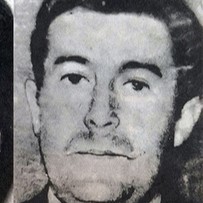
b: 1950
Carlos Alberto Topp Collins
Summary
Name:
Nickname:
Viña del Mar psychopathYears Active:
1980 - 1981Birth:
January 25, 1950Status:
ExecutedClass:
Serial KillerVictims:
10Method:
ShootingNationality:
Chile
b: 1950
Carlos Alberto Topp Collins
Summary: Serial Killer
Name:
Carlos Alberto Topp CollinsNickname:
Viña del Mar psychopathStatus:
ExecutedVictims:
10Method:
ShootingNationality:
ChileBirth:
January 25, 1950Years Active:
1980 - 1981Date Convicted:
January 8, 1983bio
Carlos Alberto Topp Collins was born on January 25, 1950, in Chile. A former member of the Carabineros, Chile's national police force, he served alongside Jorge José Sagredo Pizarro, who would later become his co-conspirator in one of Chile’s most horrifying serial murder cases.
Not much is publicly known about Topp’s early life, education, or family background. His association with law enforcement gave him access to weapons, institutional knowledge, and a level of public trust, privileges he and Sagredo would ultimately betray. At the time of the murders, both men were active-duty officers, using their authority and uniforms to lure victims, commit rapes, and execute killings, mostly around Viña del Mar.
murder story
Between August 1980 and November 1981, Carlos Topp and Jorge Sagredo committed a string of 10 brutal murders and 4 rapes across Viña del Mar and nearby towns. The pattern of their crimes suggested premeditation, coordination, and the misuse of their police status to gain access to vulnerable targets.
Some of their most horrific attacks included:
In multiple cases, the women were raped after their partners were killed. The pair often stole taxis, used official police tone and behavior, and carried out the murders in secluded outdoor areas.
After a two-year investigation involving both the Carabineros OS7 Narcotics Division and the PDI (Chilean Investigations Police), suspicions turned inward. A Carabinero named Juan Quijada noticed that the killers spoke with an authoritative tone, consistent with police officers. He reported Sagredo, who soon confessed and implicated Topp.
The two men were arrested on March 8, 1982, just four days after being discharged from the Carabineros. They gave extrajudicial, judicial, and public confessions to the crimes. Despite claiming some killings were carried out under orders from a "crime club", which allegedly included political elites and businessmen, only the two officers were prosecuted.
Their trial began immediately, and on January 8, 1983, they were sentenced to death by firing squad. This sentence was unanimously upheld by the Court of Appeals of Valparaíso and confirmed by the Chilean Supreme Court on January 17, 1985.
Relatives of several victims, many of whom were leftists targeted during the Pinochet regime, protested the execution. They believed the killers were used by state-aligned death squads, and that higher-level figures, such as Luis Gubler Díaz, were protected. Despite evidence tying Gubler’s revolver to four murders, he was released after a court deemed his confession was obtained through torture. Nevertheless, President Augusto Pinochet denied clemency, and the executions proceeded.
On January 29, 1985, Carlos Topp and Jorge Sagredo were executed by firing squad at Quillota Prison. They were tied to chairs, red paper targets placed over their hearts, and shot in accordance with Chilean military protocol.